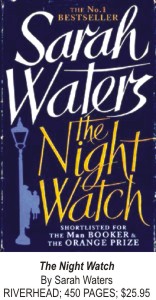Book Review
Londoners Emerge from Bunkers into a Strange New World
Tess Taylor
 Reading the beginning of Sarah Waters' new novel, "The Night Watch," is a bit like being dropped into the narrative world of "Mrs. Dalloway." Lights up on Kay, 1947, looking out her boardinghouse window. On the porch below, she watches one of her Scientologist landlord's patients arriving: "So this", said Kay to herself, "is the sort of person you've become: a person whose clocks and wrist-watches have stopped, and who tells the time, instead, by the particular kind of cripple arriving at her landlord's door." Reading the beginning of Sarah Waters' new novel, "The Night Watch," is a bit like being dropped into the narrative world of "Mrs. Dalloway." Lights up on Kay, 1947, looking out her boardinghouse window. On the porch below, she watches one of her Scientologist landlord's patients arriving: "So this", said Kay to herself, "is the sort of person you've become: a person whose clocks and wrist-watches have stopped, and who tells the time, instead, by the particular kind of cripple arriving at her landlord's door."
Waters' book will move on a different scale than Virginia Woolf's. "Mrs. Dalloway" condenses and follows the life of one woman through one day in 1923, while "The Night Watch" traces the minds and lives of three women and a man during five years. Nevertheless, Kay's startled, dislocated self-recognition, the pace of her interior monologue and the streams of observation that move out of her head and into the city seem as if they owe a debt to Woolf.
It's not a bad time to juggle a few Clarissa Dalloways: London is just emerging from the blitz and there's a lot to see and feel. Kay, a mannish butch who was a "night watch" ambulance driver during the war, finds that the world around her, which valued her during the war, mocks her again. She's stumblingly trying to make sense of what has happened. She only half recognises people and sights on the street. The book's other characters face similar struggles. Duncan, who had been in prison, finds himself working in a candle factory. Viv wonders if she still loves her married soldier boyfriend. Helen believes that her girlfriend, Julia, a rising novelist, is on the verge of leaving her. As the city is rebuilt, everything seems ready to be re-evaluated.
Waters gained recognition for three novels depicting the seamy underside of Victorian England, and a little bit of notoriety when her book "Fingersmith" depicted steamy lesbian sex on the BBC. "The Night Watch" keeps lots of lesbian sex but ventures into new territory by describing wartime London. Waters captures her new time period by following the ways the lives of her four characters overlap. It's a complicated web, one that they don't necessarily even know about: Duncan's sister's workmate might have tattled on him during the war. Kay might have rescued Viv's soldier boyfriend. Duncan's cellmate might want to date Viv now.
But what does it all add up to? The novel is full of little dislocations. The chaotic background of the war fosters a landscape of unexpected partings and joinings. People seem surprised by each other and themselves. On a walk, Duncan and Viv catch a glimpse of themselves: "As they headed back to Oxford Street they had to pause at a kerb alongside a window; she saw the two of them reflected in it, and met his gaze through the glass. ... They looked like a couple -- a simple, nice-looking, young courting couple." This observation is true enough. It's a fact that they are not what they seem, and that they aren't even sure what they are goes on being unsettling.
Waters captures a lot of moments like this: She lets us gaze into a lot of windows and climb the stairs of more than one sordid hotel. She's got a gift of inhabiting each suite of rooms with precise attention. Occasionally this makes for what seems to be a preponderance of detail:
"Helen envied Viv her hair. Her own hair was light -- or, as she thought of it now, colourless; and it did that unforgivable thing -- grew absolutely straight. She wore it waved, and the constant perming dried it out and made it brittle. She'd had it waved very recently: she could catch the faint stink of the chemicals every time she turned her head."
It's not that this is dull: It's not, exactly. It says a lot about Helen and it captures the way a person might feel and think in a period. It's just that the book, which is studded with such insights, in the heads of its characters, occasionally seems burdened by all the accounting for thinking that it's doing. Why does this book need to focus so closely as it is moving backward over such great spans of time? What is gained through these close-ups? Is it even possible to keep the larger picture in sight?
Indeed, this fragmentation -- the fact that each moment is so deeply felt and then lost in a sea of change -- might be the novel's point. All the chronicling of thought and observing the world through these four sets of eyes occasionally feels as if it is following too many kinds of minutiae through too much time. One wishes for the condensation of only one Clarissa Dalloway. Still, the novel frequently rescues itself through sheer force of its observation. If it is not always entirely clear why the book needs to move backward, to find out at the end what people were five years before the novel began, Waters has woven a nuanced tapestry of consciousnesses.
This review first appeared in The San Francisco Chronicle.
Copyright (R) thedailystar.net 2007 |
